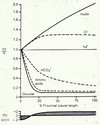Tubular Absorption and Secretion Flashcards
(50 cards)
What parts of excretion is tightly controlled? What has no control?
Filtration has no regulation.
Absorption and secretion are tightly regulated
Which molecules have 100 or nearlt 100% filtered load reabsorbed?
Glucose
Bicarb
Sodium
Chloride
What molecule has 50% filtered load reabsorbed?
Urea
What molecule has 0% filtered load reabsorbed?
Creatinine
Where does the majority of reabsorption happen?
- Majority reabsorption in proximal tubule (60%)
- Little in loop of henle and distal tubule
- In general, of the total filtrate coming into the nephrons, the proximal tubule reabsorbs:
- ▪ 65% to 70% of the Na + and H 2 O
▪ 80% to 85% of the K +
▪ 65% of the Cl −
▪ 75% to 80% of the phosphate
▪ 100% of the glucose
▪ 100% of the amino acids
After this bulk reabsorption, “fine-tuning” of the reabsorption of the remaining tubular fluid occurs in subsequent segments of the nephron.
What are the 2 different pathways that the nephron absorbs substances?
Transcellular- most common way.
Paracellular- pulling from between cells. Junctions in nephron very tight, so not a lot of paracellular movement
What is active transport?
Using ATP to move molecules against their concentration gradient
What is secondary active transport
- Secondary active transport is how we absorb everything in kidney
- Everything uses secondary active transport except reabsorbing bicarb
- Uses energy of created concentration gradient to move other ion (sometimes the ion being brought in is going against concentration gradient)
- i.e. Na/K ATPase creates gradient. Decreases Na inside cell
- Now sodium can come into cell, bringing glucose, which glucose can be coming in against its concentration gradient
Where is countertransport used in kidney?
To secrete substances into nephron
What is exception to rule for absorption in kidney?
Bring in bicarb with counter transport (typically we secrete with counter transport)
What is the general location for transporters in cellular membrane of kidney?
- High [Na] and [Glucose] in tubule,
-
Apical membrane
- Bunch of Na/Glucose symporter channels
- Create [Na] gradient by Na/K ATPase pump on basolateral membrane
- Allows us to move Na and glucose down created concentration gradient, into cell
- GLUT-2 transporter on basolateral membrane to facilitate with diffusion into capillary
What is Tmax?
Transport max.
- Maximum amount of solute transport can handle. Property of the channel
- After Tmax, will begin to see solute excreted in urine
What is splay?
- reference to heterogeneity of nephron, some shorter, some do not have a lot of tubule. That’s why there’s a curved line at filter and excretion
- Why we see glucose in urine before we expect it

Which substrates are absorbed in proximal tubule?
- Glucose
- Amino acids
- Acetate
- Krebs cycle intermediates
- Water-soluble vitamins
- Lactate
- Acetoacetate
- Many others
- all are 100% reabsorbed attached to Na
What are some characteristics of typical transport process?
- They are (secondary) active
- They manifest a Tmax
- Well above what is normally filtered
- They manifest specificity
- They are inhibitable by drugs and disease
What is filtered load?
GFRx Px
- Filtered load= how much moves to blood into nephron
- Na has highest filtered load of any ion
- Under hormonal control
- For excretion, we can go as low as 5% or as high as 99% based on bodies needs
- Na is reabsorbed in 3 areas:
- 1) Proximal tubule (65-75%)
- 2) Part of loop of henle (15-20%)
- 3) Distal tubule and top of collecting duct (5-7%)
What is ion movement in Na/K ATP ase pump?
2 K in for 3 Na out using ATP
What is the only antiport in proximal tubule?
Na/H antiport for acid/base regulation
What does movement of Cl in proximal tubule look like?
- As Na absorbed, H2O follow
- Moving lots of positives into intracellular space
- Cl- then comes in because of positive gradient created
- Cl- is pulled in via paracellular pathway
- Only allowed because strong electrochemical gradient created
Describe this graph.

- [Na] stays the same because taking H2O with it (line remains at 1)
- As going down tubule, reabsorbing mass Na and water follows
- Lost Na down tubule, but [Na] does not change!
- So much Na is reabsorbed!!
- Amino acids, HCO3, glucose curve down because concentration is so much lower than Na.
- These are absorbed at beginning of tubule
- Inulin’s line, not reabsorbed or excreted!
- Cl- line is delayed increase because it follows electrochemical gradient created by Na

Describe the loop of henle, purpose and what is absorbed there.
- Shaped like horseshoe, essential to function of creating osmotic gradient
-
Descending limb- completely impermeable to solute, no reabsorption/secretion
- ONLY permeable to H2O
- AKA Concentrating segment
-
Ascending limb- impermeable to H2O permeable to solute
- Aka-Diluting limb
What types of transporters are found in thick ascending loop of henle?
- Basolateral membrane= Na/K ATPase pump
- Inside lumen, sodium will move down concentration gradient
- 4 things moving in via transporter on apical membrane=
- 1 Na
- 1 K
- 2 Cl
- Other transporters to allow K/Cl to be reabsorbed/ Not focusing on that right now
What are the 2 types of cells in distal tubule?
Principal Cell
Intercalated cells
What is transported on principal cells?
- Na/K ATPase on basolateral membrane
- Na out, K in, low concentration Na gradient in cell
- Na/Cl symporter on apical side
- Cl molecule has chloride channel on basolateral membrane, Cl able to move out on own via channel







